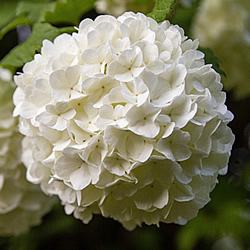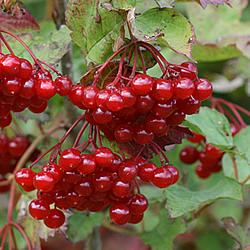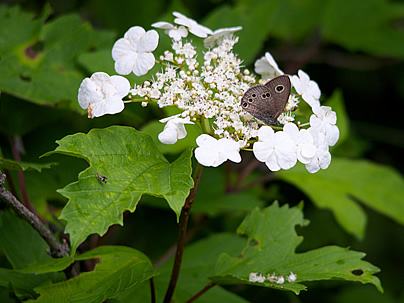The Guelder Rose (Viburnum opulus) is a deciduous shrub, known for its abundant flowering, native to Europe and Asia, and cultivated as an ornamental plant in regions with a subtropical to temperate climate. Its branches are woody, branching out from the base, but with an open texture. The leaves are opposite, three-lobed, with a rounded base, serrated margins, and well-defined veins, giving the leaf surface a rough texture. In the autumn, the leaves take on beautiful bronze tones before falling off in winter.

It blooms from late spring to summer, producing corymb-type inflorescences with numerous hermaphroditic flowers that range from white to pale pink and are delicately fragrant. The inflorescences have an umbrella-like shape with a somewhat flat surface, and the flowers on the edges are often larger than those in the center, similar to some varieties of Hydrangeas (Hydrangea macrophylla).
There are also other cultivars of the Viburnum opulus, with one featuring double flowers, beautiful full and globular inflorescences, known as ‘Sterile’ and commonly referred to as the “snowball bush”, being the most popular. The formed fruits are spherical and red, with an acidic taste. They are edible in small quantities, ornamental, and quite attractive to birds.

In the garden, the guelder rose can be used as a standalone specimen, in rows, groups, or alongside other plants, always respecting its informal and free-spirited appearance. It makes an excellent backdrop for shorter species and vibrant-colored flowers.
The Viburnum opulus is also an interesting plant to train as a climber, using ties and guidance. The seasonal variation of this shrub makes it captivating and different in every season, especially in regions with distinct climates ranging from subtropical to temperate. It can also be planted in pots and is suitable for the art of bonsai.
It should be grown in full sun or partial shade, in fertile soil, preferably acidic, well-draining, enriched with organic matter, and regularly irrigated. It tolerates cold weather, as well as light frosts. After flowering, it is advisable to remove the weaker and older branches from the base to aerate the plant and stimulate new growth. Fertilize the guelder rose with well-rotted barnyard manure during spring and summer. It can be propagated by semi-woody and woody stem cuttings, which are planted to root in the spring.


